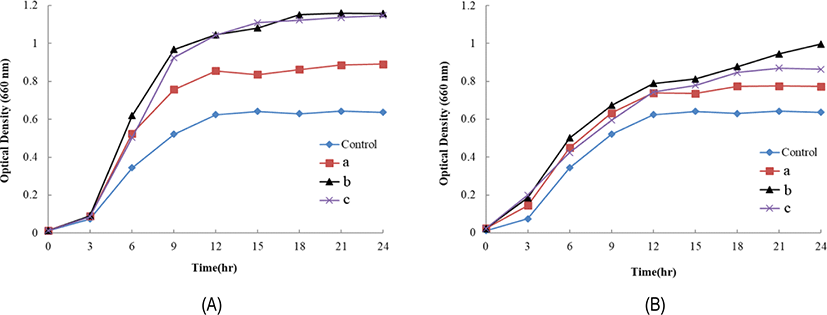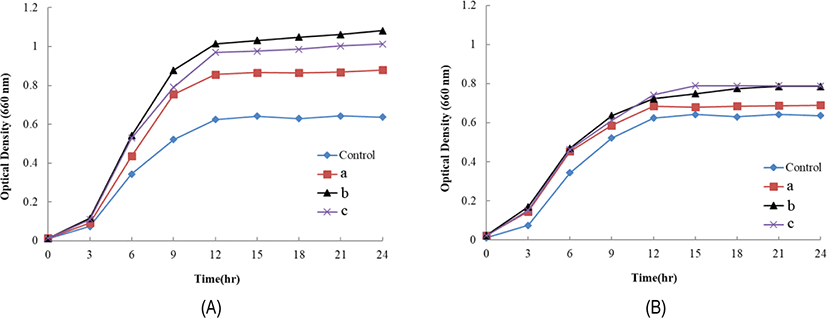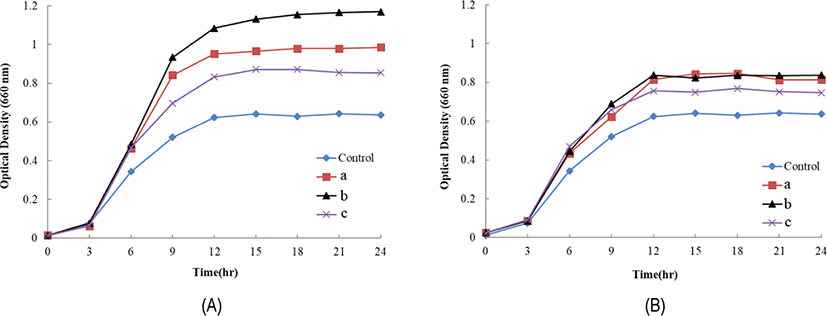Introduction
The term “probiotics” has been defined as follows: “live microorganisms which, when administered in adequate amounts, confer a health benefit to the host” (FAO/WHO, 2002). Probiotics are food supplements containing live microbes that beneficially affect the host by improving microbial balance (Fuller, 1989). Lactococcus lactis subsp. cremoris are predominantly found in Caspian Sea Yogurt. In general, Lc. cremoris strains have been used in starter cultures for yogurt and other fermented dairy products, and they are one of the most important groups of lactic acid bacteria. In a double-blind crossover study based on a conventional culture method, Toda et al. (2005) demonstrated the probiotic effect of fermented milk containing Lc. cremoris on the intestinal microbiota of healthy elderly people. According to the report of Maruo et al. (2006) the decrease in occurrence of Clostridium perfringens in fermented milk with Lc. cremoris may be due to the probiotic properties (i.e., survival through the gastrointestinal tract and beneficial effects on human health) of viable Lc. cremoris FC. We showed the prebiotic and probiotic effects of oligosaccharides on the viability of Lc. cremoris during refrigerated storage (Kafley et al., 2008). In the present study, after 48 h of incubation, most of the oligosaccharides added in the experiment stimulated the growth of Lc. cremoris.
Milk is known to contain several protective proteins, including lactoferrin, that help preserve it. Lactoferrin is an 80-kDa glycoprotein member of the transferrin family of iron-binding proteins. It is found in various mammalian secretions such as milk, tears, saliva, and synovial fluid, as well as in the secondary granules of neutrophils and blood (Shimazaki, 2000). Lactoferrin is known to exhibit a diverse range of biological effects, including antibacterial, anticancer, anti-inflammatory, antiviral, antioxidant, cell growthpromoting, and immunomodulatory properties (Farnaud and Evans, 2003). Additionally, lactoferrin has been shown to inhibit the growth of a number of bacteria (Shimazaki, 2000). We previously examined the effects of apo-, holo-, and native- lactoferrin on the growth of Lactobacillus acidophilus and Bifidobacterium (Kim et al., 2004a; 2004b).
The thermal stability of lactoferrin has been well reported (Ruegg et al., 1977). However, the effect of heat-treated lactoferrin on the growth of lactic acid bacteria has not yet been reported. Therefore, this study aimed to investigate whether heat-treated bovine lactoferrin can promote the growth of Lc. cremoris JCM 20076.
Materials and Methods
Lc.cremoris JCM 20076 was obtained from Japan Collection of Microorganisms. Lc. cremoris JCM 20076 was routinely grown in MRS broth (Difco, USA) at 30°C in aerobic conditions. The bacteria were maintained as frozen stocks at −80°C in the appropriate medium containing 25% (v/v) glycerol. Native bovine lactoferrin prepared by Morinaga Milk Industry Co. Ltd. (Zama, Japan) was used. Apo- and holo-lactoferrin were prepared according to the methodology described by Shimazaki and Hosokawa (1991). Briefly, bovine lactoferrin was dialyzed against 0.1 M citric acid for 24 h, pure water for 48 h, and then finally against 0.05 M phosphate buffer (pH 6.5), containing 0.05 M NaCl to obtain apo-lactoferrin. On the other hand, holo-lactoferrin was prepared as follows: native bovine lactoferrin was dissolved in 0.9 mL of 0.05 M sodium bicarbonate-citric acid buffer (pH 7.5), and then excess iron (III) ammonium citrate was added to the solution. After incubation for certain periods at 37°C, the solution was applied on an affinity chromatography column packed with heparin-Sepharose (Pharmacia AB, Uppsala, Sweden). The equilibrating buffer for affinity chromatography was 0.01 M phosphate buffer, pH 7.0, and the eluting buffer was 0.01-M phosphate buffer, pH 7.0, containing 1 M NaCl.
Lc. cremoris JCM 20076 was propagated in minimum concentrations of MRS broth (Difco, USA) at 30°C. Briefly, the concentration of MRS broth was diluted to one-fifth of the original concentration (1/5 dilution) using distilled water to serve as minimum media (Kim, 2017).
The bovine lactoferrin preparations were dissolved in distilled water to a concentration of 1 or 2 mg/mL. Bovine lactoferrin (apo-, holo-, and native-lactoferrin) was exposed to heat treatments of 85°C for 5 min and 65°C for 30 min, respectively. These samples were then tested for their effects on the growth of Lc. cremoris JCM 20076. The enthalpies of the different heat-treated samples were compared with that of the nonheat-treated bovine lactoferrin.
Growth of Lc. cremoris JCM 20076 treated with various heat-treated bovine lactoferrin (apo-, holo-, and native-lactoferrin) samples was measured using a 96-well microplate assay. The test strains of Lc. cremoris JCM 20076 were pre-incubated in MRS broth at 30°C. The lactoferrin samples were filter-sterilized (0.22 μm). In each well of a 96-well microplate, the prepared lactoferrin samples were mixed with adjusted MRS broth (1/5 dilution) to a final volume of 200 μL, and then inoculated with 1% of precultured test strain. Heat-treated bovine apo-lactoferrin, holo-lactoferrin, or native- lactoferrin was added at concentrations of 1 and 2 mg/mL. After sealing, the microplates were incubated for 24 h at 30°C. Every 4 h during incubation, the growth was monitored by measuring the optical density at 660 nm using a microplate reader (Bio-Rad, Hercules, CA, USA).
Results and Discussion
The growth of Lc. cremoris JCM 20076 was observed when bacteria were grown in adjusted MRS medium (1/5 dilution) in the presence or absence of heat-treated bovine native-lactoferrin, apo-lactoferrin, and holo-lactoferrin at different concentrations (1 and 2 mg/mL). The addition of non-heat-treated and heat-treated bovine lactoferrin, respectively, in adjusted MRS medium stimulated the growth of Lc. cremoris JCM 20076. The impact of heat-treated bovine lactoferrin on the growth of Lc. cremoris JCM 20076 was higher than that of the non-heat-treated one (Fig. 1, 2, and 3). The growth stimulation effect was dependent on the temperature and duration of the heat treatment on bovine lactoferrin (Fig 1, 2, and 3). In particular, a more pronounced growth stimulation was observed in bovine lactoferrin heat-treated at 65°C for 30 min and 80°C for 5 min at a concentration of 1 mg/mL (Fig. 1A, 2A, and 3A).



Fig. 1 illustrates that the growth of Lc. cremoris JCM 20076 upon incubation with bovine native-lactoferrin for 24 h was in the following order: 65°C for 30 min>80°C for 5 min>non-heat-treated bovine native-lactoferrin. Growth of Lc. cremoris JCM 20076 was promoted at a concentration of 1 mg/mL rather than at 2 mg/mL (Fig. 1).
Fig. 2 shows the growth of Lc. cremoris JCM 20076 after addition with heat-treated and non-heat-treated bovine apo-lactoferrin. Heat-treated bovine apo-lactoferrin at a concentration of 1 mg/mL significantly stimulated the growth of Lc. Cremoris JCM 20076 (Fig. 2A). The degree of growth stimulation induced by the treatments was in the following order: 65°C for 30 min>80°C for 5 min>non-heat-treated bovine apo-lactoferrin (Fig. 2A). However, there was no significant difference between the effects of the two heat-treated bovine apo-lactoferrin samples at a concentration of 2 mg/mL (Fig. 2B).
Fig. 3 shows the growth of Lc. cremoris JCM 20076 after addition of heat-treated and non-heat-treated bovine holo-lactoferrin. As illustrated in Fig. 3, the degree of growth stimulation induced by the treatments was in the following order: 65°C for 30 min>non-heat-treated bovine holo-lactoferrin>80°C for 5 min. Addition of bovine hololactoferrin heat-treated at 80°C for 5 min showed a weaker influence on the growth of Lc. cremoris JCM 20076 than non-heat-treated bovine holo-lactoferrin (Fig. 3A and 3B).
In the present study, heat treatment of bovine lactoferrin at 65°C for 30 min stimulated the growth of Lc. cremoris JCM 20076 better than non-heat-treated bovine lactoferrin. Furthermore, growth was highly increased by supplementation with heat-treated bovine lactoferrin at a concentration of 1 mg/mL.
There is growing interest in lactoferrin as a nutritional ingredient. Typically, exposure of a protein to heat can impair its function. Therefore, the heat stability of lactoferrin is a very important trait, and is an important factor in determining the efficacy of infant formulas and other milk products supplemented with this protein (Indyk et al., 2007).
Previous studies have examined the thermal stability of lactoferrin and its antibacterial activity against pathogenic bacteria. Paulsson et al. (1993) reported that iron-saturated lactoferrin was more resistant to heat-induced changes than apo-lactoferrin. The ability of native and iron-saturated lactoferrin to bind various bacterial species was unaffected by pasteurization. Therefore, the authors reported that both non-heat-treated and pasteurized lactoferrin showed similar antibacterial properties. Harouna et al. (2015) reported that the antibacterial activity of native bovine lactoferrin against Cronobacter sakazakii was retained even with heat treatments at 72°C for 15 s, 85°C for 15 s, and 63°C for 30 min. They also reported that lactoferrin exhibited antibacterial activity after heat treatment at 72°C for 15 min and 85°C for 10 min against Cronobacter sakazakii; however, the antibacterial activity was slightly lower. The bacteriostatic or antibacterial activity effects of lactoferrin can be described in two ways. Firstly, since almost all bacteria require iron for their growth, lactoferrin devoid of iron can prevent bacteria from using it; other mechanisms can also be involved in the antibacterial activity of lactoferrin, such as blocking microbial metabolism of carbohydrates and destabilizing the bacterial cell wall (Sanchez et al., 1992; Orsi, 2004). On the other hand, bovine lactoferrin has been reported to promote the growth of lactic acid and bifidobacteria (Kim et al., 2004a; 2004b; 2004c; Kim, 2017). It has been reported that bovine lactoferrin binds to the cell membrane proteins of lactic acid and bifidobacteria, and is involved in their growth.
In this study, bovine lactoferrin promoted the growth of Lc. cremoris JCM 20076. These results are consistent with previous reports that bovine lactoferrin promoted the growth of Lc.cremoris FC (Kim, 2017). Furthermore, heat-treated bovine lactoferrin showed a greater growth promoting effect than non-heat-treated bovine lactoferrin. However, more studies need to be conducted to elucidate the mechanism by which heat-treated bovine lactoferrin exhibits a better growth promoting effect than non-heated bovine lactoferrin.






